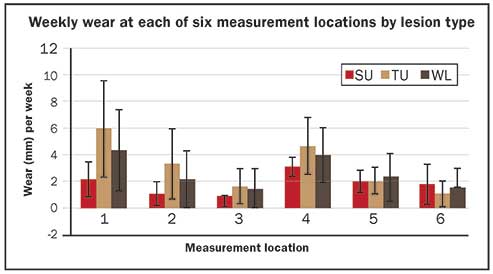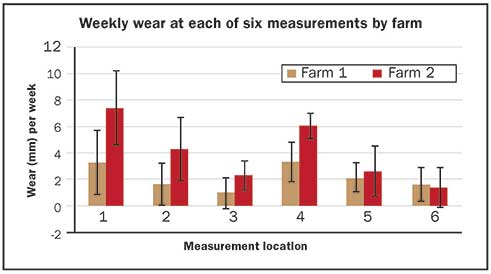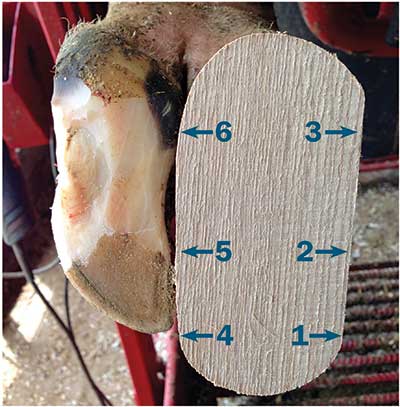Merkatoris and Döpfer are with the University of Wisconsin-Madison School of Veterinary Medicine; Burgi is with Comfort Hoof Care, Baraboo, Wis. Trinko and Pudwill are hoof trimmers. Dan Ellsworth, Animart, assisted with the study.
Wooden hoof blocks are commonly used in the treatment of toe, heel and sole ulcer-derived lameness. Traditionally, an epoxy glue is used to adhere a wooden block to the sound claw, relieving the lame claw from bearing weight, providing time to heal. While this is a highly effective method of treatment, we need a glue with a lower setting temperature.
Traditional epoxy glues have setting temperatures that exceed 300°F, which is speculated to cause damage to the hoof and inhibit healing. Polyurethane glues set at temperatures lower than 300°F, which makes them an attractive alternative to epoxy glues.
The goal of our study was to compare the persistence and wear of blocks using two different polyurethane glues on two different farms. The first type of glue chosen, "glue type one," was a polyurethane glue that was not commercially available at the time of our study. "Glue type two" was a commercially available polyurethane glue. The blocks chosen for this study were 5 inches in length and made from oak wood.

Two farms were chosen to participate based upon the availability of the hoof trimmer working at their respective farms. At Farm One, 65 blocks were applied, with 123 applied at Farm Two. A total of 188 blocks were applied to claws with lesions that met the inclusion criteria (stage two and three sole ulcers, heel ulcers, toe ulcers or wall defects, including white line abscesses and wall abscesses).
The hoof trimmers treated lesions by trimming the horn around the lesion. Manufacturer recommendations were explicitly followed in the application of the blocks, and equivalent amounts of glue (40 ml) were used for each application.
We completed weekly visual checks in the freestall pens where the cows were housed to confirm that the block stayed in place (persistence). Persistence data was recorded as: "Off" for the block being absent upon inspection or "Glue" when only glue was adhered to the foot while the block was absent. Finally, "On" was used when the block and glue were properly in place.
Cows' blocks were checked weekly until one of the following occurred: off or glue observations were made, the hoof trimmer removed the block at recheck or when the maximum block survival time of six weeks was reached, upon which the cow was removed from the study.
Measurement data were taken at the time of application and at recheck, if applicable, since not all cows were available for recheck. Measurements were made in millimeters (mm) with a caliper. Six measurements, shown in the image, were recorded: medial toe thickness of block (1), medial middle thickness of block (2), medial heel thickness of block (3), lateral toe thickness of block (4), lateral middle thickness of block (5) and lateral heel thickness of block (6).
Wear is defined as the amount of wood block lost to wear by the animal. It is calculated as the difference between the application thickness of the block and recheck thickness of the block, at each of the six measurement locations`.
At Farm One, the most blocks were applied in the treatment of sole ulcers (23/65) and white line diseases (21/65). At Farm Two, the most blocks were applied in the treatment of thin soles (62/123). Overall, 35.1 percent of blocks were applied for the treatment of thin soles, 27.1 percent for white line diseases, and 16.5 percent for sole ulcers. The time until block failure was recorded for each block, with average time until failure being 2.3 weeks. On Farm One, the average time until failure was 3.3 weeks, and on Farm Two the average time until failure was 1.8 weeks.
Wear varies with farm, lesion
The study found that both farm and lesion type affect the amount of wear a block experiences, but glue type did not. Persistence, or how long the block stayed on, was not affected by farm, lesion type or glue type.

The chart above shows differences in the amount (mm) that blocks are worn at the two farms. Rough floors, abrasive sand and lack of rubber mats can explain the apparent elevated amount of wear at Farm Two and the large number of blocks applied for the treatment of thin soles. This translates to a need for a more durable block that can withstand strong abrasive forces. A plastic block may be better suited on a farm with a high prevalence of thin soles, a common problem on farms with abrasive walking surfaces such as Farm Two. Future research would benefit from better assessing the erosive nature of flooring.
There is also a difference in amount of weekly wear when comparing lesion type. When comparing sole ulcers with white line lesions and thin soles, block wear was notably reduced on the medial side. This could be due to an altered positioning of the foot by the animal when bearing weight as a result of lesion type, or perhaps a total reduction in the amount of weight bore by the leg with the lesion. This information may be valuable to hoof trimmers and producers when considering the painfulness of a particular lesion and when treating that lesion.

Hoof blocks are applied to relieve weight on the diseased claw. In this study, blocks were applied with measurements taken at six locations: (1) medial toe thickness of block, (2) medial middle thickness of block, (3) medial heel thickness of block, (4) lateral toe thickness of block, (5) lateral middle thickness of block, (6) lateral heel thickness of block.
This study provides insight into both the persistence and wear of wooden blocks in the treatment of lameness in cattle. Perspective on how wooden blocks wear has been gained, indicating that factors such as the lesion type and the farm play a role. These are important factors to consider when deciding what type of block to use, how long to leave the block on and what type of glue is best suited.
However, this study has also opened the door to ask more questions. How does this affect how blocks should be applied? What on-farm factors are contributing to the amount of wear? How can farm factors be balanced with hoof blocking to minimize discomfort to the cow? Future research should be geared towards addressing how trimmers apply blocks and farm environment affects wear.
Click here to return to the Animal Care E-Sources
1406_426
Wooden hoof blocks are commonly used in the treatment of toe, heel and sole ulcer-derived lameness. Traditionally, an epoxy glue is used to adhere a wooden block to the sound claw, relieving the lame claw from bearing weight, providing time to heal. While this is a highly effective method of treatment, we need a glue with a lower setting temperature.
Traditional epoxy glues have setting temperatures that exceed 300°F, which is speculated to cause damage to the hoof and inhibit healing. Polyurethane glues set at temperatures lower than 300°F, which makes them an attractive alternative to epoxy glues.
The goal of our study was to compare the persistence and wear of blocks using two different polyurethane glues on two different farms. The first type of glue chosen, "glue type one," was a polyurethane glue that was not commercially available at the time of our study. "Glue type two" was a commercially available polyurethane glue. The blocks chosen for this study were 5 inches in length and made from oak wood.

Two farms were chosen to participate based upon the availability of the hoof trimmer working at their respective farms. At Farm One, 65 blocks were applied, with 123 applied at Farm Two. A total of 188 blocks were applied to claws with lesions that met the inclusion criteria (stage two and three sole ulcers, heel ulcers, toe ulcers or wall defects, including white line abscesses and wall abscesses).
The hoof trimmers treated lesions by trimming the horn around the lesion. Manufacturer recommendations were explicitly followed in the application of the blocks, and equivalent amounts of glue (40 ml) were used for each application.
We completed weekly visual checks in the freestall pens where the cows were housed to confirm that the block stayed in place (persistence). Persistence data was recorded as: "Off" for the block being absent upon inspection or "Glue" when only glue was adhered to the foot while the block was absent. Finally, "On" was used when the block and glue were properly in place.
Cows' blocks were checked weekly until one of the following occurred: off or glue observations were made, the hoof trimmer removed the block at recheck or when the maximum block survival time of six weeks was reached, upon which the cow was removed from the study.
Measurement data were taken at the time of application and at recheck, if applicable, since not all cows were available for recheck. Measurements were made in millimeters (mm) with a caliper. Six measurements, shown in the image, were recorded: medial toe thickness of block (1), medial middle thickness of block (2), medial heel thickness of block (3), lateral toe thickness of block (4), lateral middle thickness of block (5) and lateral heel thickness of block (6).
Wear is defined as the amount of wood block lost to wear by the animal. It is calculated as the difference between the application thickness of the block and recheck thickness of the block, at each of the six measurement locations`.
At Farm One, the most blocks were applied in the treatment of sole ulcers (23/65) and white line diseases (21/65). At Farm Two, the most blocks were applied in the treatment of thin soles (62/123). Overall, 35.1 percent of blocks were applied for the treatment of thin soles, 27.1 percent for white line diseases, and 16.5 percent for sole ulcers. The time until block failure was recorded for each block, with average time until failure being 2.3 weeks. On Farm One, the average time until failure was 3.3 weeks, and on Farm Two the average time until failure was 1.8 weeks.
Wear varies with farm, lesion
The study found that both farm and lesion type affect the amount of wear a block experiences, but glue type did not. Persistence, or how long the block stayed on, was not affected by farm, lesion type or glue type.

The chart above shows differences in the amount (mm) that blocks are worn at the two farms. Rough floors, abrasive sand and lack of rubber mats can explain the apparent elevated amount of wear at Farm Two and the large number of blocks applied for the treatment of thin soles. This translates to a need for a more durable block that can withstand strong abrasive forces. A plastic block may be better suited on a farm with a high prevalence of thin soles, a common problem on farms with abrasive walking surfaces such as Farm Two. Future research would benefit from better assessing the erosive nature of flooring.
There is also a difference in amount of weekly wear when comparing lesion type. When comparing sole ulcers with white line lesions and thin soles, block wear was notably reduced on the medial side. This could be due to an altered positioning of the foot by the animal when bearing weight as a result of lesion type, or perhaps a total reduction in the amount of weight bore by the leg with the lesion. This information may be valuable to hoof trimmers and producers when considering the painfulness of a particular lesion and when treating that lesion.

This study provides insight into both the persistence and wear of wooden blocks in the treatment of lameness in cattle. Perspective on how wooden blocks wear has been gained, indicating that factors such as the lesion type and the farm play a role. These are important factors to consider when deciding what type of block to use, how long to leave the block on and what type of glue is best suited.
However, this study has also opened the door to ask more questions. How does this affect how blocks should be applied? What on-farm factors are contributing to the amount of wear? How can farm factors be balanced with hoof blocking to minimize discomfort to the cow? Future research should be geared towards addressing how trimmers apply blocks and farm environment affects wear.
1406_426








